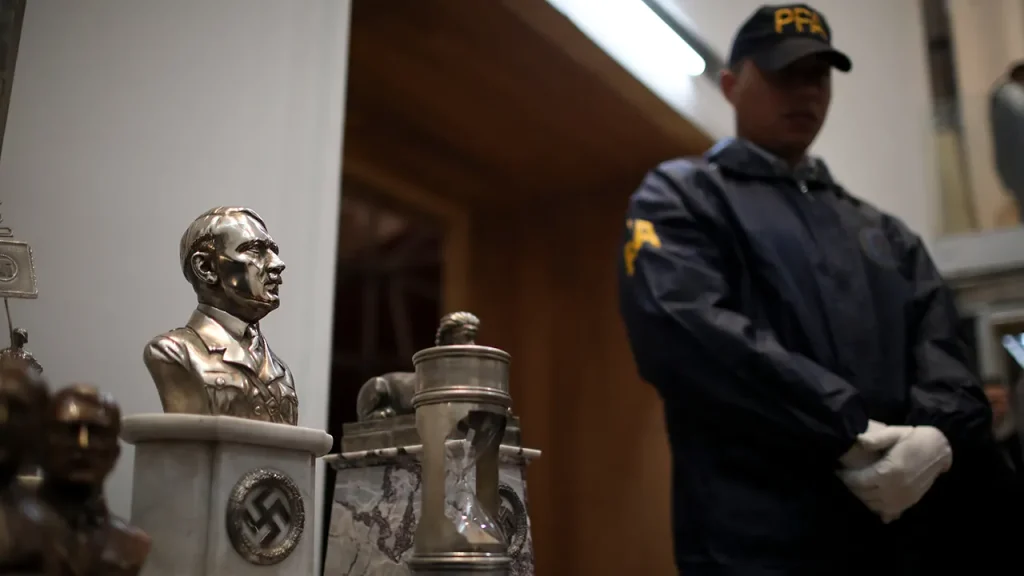Argentina’s Revelation: Unveiling the Nazi Shadows
In a historic move earlier this year, Argentine President Javier Milei declassified over 1,850 documents comprising thousands of pages that detail Argentina’s efforts to track and verify thousands of Nazi war criminals who fled Europe after World War II. This unprecedented release was spurred by efforts from U.S. Senate Judiciary Committee Chairman Chuck Grassley, who received credit from the Simon Wiesenthal Center for pushing this initiative forward. The documents, mostly covering investigations from the late 1950s through the 1980s, were digitized and made publicly available on Argentina’s General Archive website, along with previously secret presidential decrees spanning from 1957 to 2005. For decades, these papers remained hidden, concealing a dark chapter in Argentina’s history—the systematic sheltering of some of the most notorious architects of the Holocaust.
The declassified archives reveal disturbing details about Nazi fugitives who rebuilt their lives in South America. Adolf Eichmann, the engineer of the Holocaust’s “Final Solution,” features prominently in these files. Living under the alias Ricardo Klement near Buenos Aires, Eichmann remained hidden until Mossad agents captured him in 1960, secretly transporting him to Jerusalem to face justice. The documents present contradictory evidence suggesting Juan Perón’s populist government not only knew of Eichmann’s presence but actively protected him. Other infamous figures documented include Josef Mengele, the “Angel of Death” doctor from Auschwitz who escaped to Paraguay and Brazil, dying in 1979; Martin Bormann, Hitler’s right-hand man; Croatian war criminal Ante Pavelic; Rudolf Hoess, who defected after serving as deputy führer; and Klaus Barbie, the notorious “Butcher of Lyon.” These files paint a complex picture of Argentina’s complicity in harboring these fugitives from justice.
As Harley Lippman, a member of the United States Commission for the Preservation of America’s Heritage Abroad, notes, the significance of these revelations cannot be overstated. “There are numerous questions that these documents can bring light to, as to why a sophisticated society, far from the plagues of European antisemitism such as Argentina’s, agreed to hide Nazi criminals and their secrets for so long,” Lippman observes. He raises pointed questions about the fate of Nazi gold reportedly transported to Argentina via U-boats and handed over to authorities. While Lippman acknowledges the shame in Argentina keeping these documents secret for so long, he also recognizes the current government’s courage in finally making them public. “While the historical significance is important,” he emphasizes, “this is more important for Argentinians to be able to confront their demons as a society than for Jews.” This reckoning represents a crucial step toward historical accountability.
The revelations didn’t end with the initial document release. In May, during renovations of Argentina’s Supreme Court, workers discovered an astonishing trove of 83 boxes containing Nazi documents that had remained virtually untouched in the building’s basement for nearly 84 years. These materials had been intercepted by Argentine customs in 1941 while en route from the German Third Reich Embassy in Tokyo to Buenos Aires aboard a Japanese steamer called Nan-a-Maru. Originally seized under orders from Argentina’s foreign minister to maintain the country’s wartime neutrality, the shipment became subject to an investigation of “anti-Argentine activities,” after which the Supreme Court took possession. The forgotten crates contained propaganda materials intended to spread Hitler’s ideology throughout South America, potentially to bring neutral countries under German influence during the war.
After opening these long-forgotten boxes alongside prominent members of Argentina’s Jewish community, the court acknowledged “the historical relevance of the find and the potential crucial information it could contain to clarify events related to the Holocaust,” ordering a comprehensive examination of all materials. Though the contents haven’t yet been made public, President Milei’s office has committed to declassifying and publishing these documents once digitization is complete. Cabinet Chief Guillermo Francos explained the president’s reasoning: “There is no reason to continue withholding that information, and it is no longer in the interest of the Republic of Argentina to keep such secrets.” This commitment to transparency marks a significant break with decades of official silence and obfuscation about Argentina’s Nazi connections.
Beyond documenting the escape routes—or “ratlines”—used by Nazi officials, these archives may reveal crucial information about financial institutions’ complicity in the Holocaust. As Lippman poignantly observes, “The Holocaust was the greatest theft in history. Many Swiss banks would not release funds to sometimes a sole survivor from a family who perished in the Holocaust without a death certificate for their loved ones. But Auschwitz did not issue death certificates—they only issued ashes.” This documentation emerges at a troubling moment when antisemitism is resurging globally. Lippman notes that Jews experienced “a golden age of about 80 years where antisemitism had subsided,” but believes this period has ended, partially in response to recent conflicts in the Middle East and partly because younger generations lack understanding about the Holocaust’s magnitude. “The Holocaust was the largest systematic industrial killing of humans in history. This happened only 80 years ago,” he reminds us. “Young people seem not to be able to grasp the scale of this, but these documents can bring back the memory of what the Holocaust really was.” As witnesses to history pass away, these primary sources become increasingly vital for preserving historical truth against denial and distortion, ensuring future generations understand the horrors of the past to prevent their recurrence.















